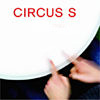In 2002, CIRCUS S presents two premieres:
In both performances, the six musicians, their
multifarious instruments and the electronic sound sources are positioned all
around the tent. Along with conventional large and small drums, vibraphone and
gongs, the instrumentation includes large cacti, aquaria and tree branches. The
audience can freely choose where to sit - on cushions, chairs and
benches.
|
 |
Programme 1 MUSICIRCUS +
The MUSICIRCUS by John Cage (born 90 years ago, died 10
years ago in August) is conceived to unify very different musics. He uses every
means at his disposal to create disorientation, lightheartedness, melodiousness
and much that is unexpected; in their MUSICIRCUS+ CIRCUS S also incorporate
contributions from local children's and amateur music groups.
John Cage

(5. September 1912 -
12. August
1992) |
Open Cages, a closed CIRCUS ON Silence
(1979/2002)
a means of translating a book into a performance without
actors, a performance which is both literary and musical
realised from
John Cage’s Silence by Arnold Marinissen, Massimo Mariani and
Stephan Meier |
Jan Boerman
 |
Kringloop I (1994/95)
tape music |
Karlheinz Stockhausen
 |
“Leo“ (23.7. - 22.8.) and “Virgo“
(23.8. - 22.9.) from
TIERKREIS - 12 melodies of the Zodiac |
Volker Staub
 |
from Waldstücke Nr.
24, Teil I (1987-94) |
John Cage
 |
from Song Books
(1970) |
José-Maria
Sanchez-Verdù  |
Refranh (2002, first
performance) commission for CIRCUS S as ”jingle“ |
| Children‘s groups
|
Orchestra dei Rumori con i bambini dellEstate in
Citta di Seveso/
Niedersächsischer Landesjugendzirkus; Klasse 9a
der Goetheschule / project-participants from Utrecht |
John Cage
 |
Trio (1939) percussion trio
cComposed Improvisation (1990)
Variations I any
number of players, any sound producing means (1958)
BRANCHES (1975)
for amplified plant materials |
Nikolaus A. Huber
 |
Clash Music (1989)
|
John Cage
 |
Sonata for Two Voices (1933)
for any two ore more instruments |
Ron Ford
 |
curves (2000) for theremin |
|
José-Maria Sanchez-Verdù
 |
Refranh (2002) ”jingle“ |
| Guest musicians |
from Milano / Hannover / Utrecht |
|
John Cage
 |
Six (1991) |
Helmut Oehring
 |
looser/sex (2002, instrumentation,
arrangement: Stephan Meier, first performance) percussionsextett and tape,
commission for CIRCUS S |
|
Programme 2 Pulsar
The high artifice of Pulsar lets sounds arise, wander and
decay within, between and around the listeners. Karlheinz Stockhausen gives
birth to the music of each one zodiac sign; Gérard Grisey takes the
rhythms of two pulsar stars as the basis of a roaring, thundering ambient sound
experience.
|
Karlheinz Stockhausen 
(*1928) |
from TIERKREIS - 12 melodies of the star signs
(1975/2002)
arranged for percussion quartett and musical boxes distributed
around a tent
by Stephan Meier
Libra (23.9. - 22.10.)
Sagittarius
(22.11. - 21.12.)
Leo (23.7. - 22.8.) and
Aries (21.3. - 21.4.)
|
|
"I began to study the 12 human characters of the
Zodiac, of which I had until then only a vague idea, more thoroughly. While
inventing each melody I thought of the essences of children, friends and
acquaintances who had been born under that star sign." Each melody, finally, is
composed with all its measures and proportions in harmony with the
characteristics of its sign. Each single note of our tonal system forms in its
specific way the central tone of one melody that, originally composed for music
boxes, can be performed on any melody and/or chordal instrument. |
|
José-Maria Sanchez-Verdù

(* 1968) |
Refranh (2002)
first performance of a
commission for CIRCUS S (integral version) |
|
INTERVAL |
|
|
Gérard Grisey

(1946 - 1998) |
Le Noir de lEtoile (1989/90)
for six
percussionists, recorded sound and spatial projections of astronomic signals
prima esecuzione italiana
"For my son Raphael." |
|
"In 1967, a young astronomer detected a radio wave
signal in the form of periodic pulses coming every 1.3 seconds. Pulsars have a
diameter of no more than 30 km, but a mass equivalent to that of our sun. Part
of their radiation is emitted within the radio waveband and can thus be picked
up by large radio telescopes. Transformed into electrical signals, they can be
amplified and used to excite the membrane of a loudspeaker. The first pulsar
you will hear is the Vela pulsar, the ripples from a supernova explosion some
12,000 years ago. It spins on its axis 11 times per second. The second pulsar
is known only by its astronomical coordinates: 0329+54. It rotates 1.4 times
per second. The supernova that generated it exploded 5 million years ago, and
its radio waves take 7,500 years to reach the earth. Listen closely to the
ticking of these cosmic clocks, open the window, and wait for the right
moment." (J. P. Luminet) |
|
|